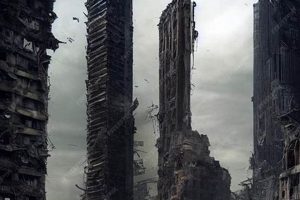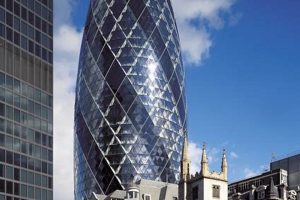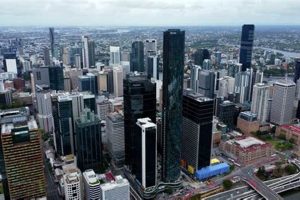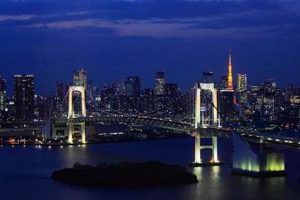Art Deco skyscrapers are a type of skyscraper that was popular in the 1920s and 1930s. They are characterized by their sleek, geometric lines and their use of decorative elements such as chevrons, zigzags, and sunbursts. Some of the most famous Art Deco skyscrapers include the Empire State Building in New York City and the Chrysler Building in New York City.
Art Deco skyscrapers were a product of the Machine Age, and they reflected the optimism and prosperity of the Roaring Twenties. They were also a symbol of the city’s growing importance as a center of commerce and culture. Art Deco skyscrapers are still admired today for their beauty and their historical significance.
In this article, we will explore the history of Art Deco skyscrapers, discuss their architectural features, and examine their impact on the cityscape. We will also take a look at some of the most famous Art Deco skyscrapers in the world.
1. Height
The height of Art Deco skyscrapers was a major factor in their popularity. In the 1920s and 1930s, there was a race to build the tallest building in the world. This race was driven by a combination of factors, including civic pride, corporate competition, and the desire to create a lasting legacy. Art Deco skyscrapers were well-suited to this race because they were able to be built to great heights without sacrificing strength or stability.The height of Art Deco skyscrapers also had a significant impact on the cityscape. These buildings were often the tallest structures in their respective cities, and they dominated the skyline. This made them landmarks and symbols of the city’s power and prosperity.One of the most famous examples of an Art Deco skyscraper is the Empire State Building in New York City. When it was completed in 1931, the Empire State Building was the tallest building in the world. It held this title for over 40 years, until the World Trade Center was completed in 1973. The Empire State Building is a classic example of Art Deco design, with its sleek lines and geometric ornamentation. It is one of the most iconic buildings in the world and a symbol of New York City.Another famous example of an Art Deco skyscraper is the Chrysler Building in New York City. The Chrysler Building was completed in 1930 and was the tallest building in the world for only 11 months, until the Empire State Building was completed. However, the Chrysler Building is still considered to be one of the most beautiful Art Deco skyscrapers in the world. It is known for its distinctive Art Deco ornamentation, including its eagles and gargoyles.The height of Art Deco skyscrapers was a major factor in their popularity and impact. These buildings were symbols of progress and prosperity, and they continue to be admired today for their beauty and their historical significance.
In addition to the Empire State Building and the Chrysler Building, other notable Art Deco skyscrapers include:
- The Bank of Manhattan Trust Building in New York City
- The Rockefeller Center in New York City
- The Merchandise Mart in Chicago
- The Hoover Building in Washington, D.C.
- The Philadelphia Saving Fund Society Building in Philadelphia
These buildings are all examples of the beauty and innovation of Art Deco architecture. They continue to be admired today as some of the most iconic buildings in the world.
2. Design
The design of Art Deco skyscrapers is one of the most distinctive and recognizable features of this architectural style. Art Deco skyscrapers are characterized by their sleek, geometric lines and their use of decorative elements such as chevrons, zigzags, and sunbursts. This design aesthetic was a product of the Machine Age, and it reflected the optimism and prosperity of the Roaring Twenties.
The design of Art Deco skyscrapers was also influenced by the Art Deco movement in the decorative arts. Art Deco was a style of art that was popular in the 1920s and 1930s, and it was characterized by its use of geometric shapes and patterns. Art Deco artists and designers were inspired by the machine aesthetic of the Industrial Revolution, and they used geometric shapes and patterns to create a sense of order and modernity.
The design of Art Deco skyscrapers was also influenced by the desire to create buildings that were both beautiful and functional. Art Deco skyscrapers were often built using new materials, such as steel and concrete, which allowed architects to create buildings that were taller and more slender than ever before. These new materials also allowed architects to experiment with new design forms, such as the setback skyscraper.
The design of Art Deco skyscrapers has had a major impact on the architecture of the 20th century. Art Deco skyscrapers are still admired today for their beauty and their historical significance. They are a reminder of the optimism and prosperity of the Roaring Twenties, and they continue to inspire architects and designers today.
Here are some examples of the design features of Art Deco skyscrapers:
- Geometric lines
- Decorative elements such as chevrons, zigzags, and sunbursts
- Setback design
- Use of new materials such as steel and concrete
These design features are what make Art Deco skyscrapers so distinctive and recognizable. They are a testament to the creativity and innovation of the architects and engineers who designed and built them.
3. Materials
The use of new materials was a major factor in the development of Art Deco skyscrapers. Prior to the 1920s, skyscrapers were typically built using masonry materials such as brick and stone. However, the development of new materials such as steel and concrete allowed architects to design and build skyscrapers that were taller and more slender than ever before.
- Steel: Steel is a strong and durable material that can be used to create lightweight and flexible structures. Steel was used extensively in the construction of Art Deco skyscrapers, particularly for the and exterior walls.
- Concrete: Concrete is a versatile material that can be used to create a variety of shapes and forms. Concrete was used in the construction of Art Deco skyscrapers for both structural and decorative purposes.
The use of new materials had a significant impact on the design of Art Deco skyscrapers. Steel and concrete allowed architects to create buildings that were taller, more slender, and more complex than ever before. These new materials also allowed architects to experiment with new design forms, such as the setback skyscraper.The use of new materials also had a significant impact on the construction of Art Deco skyscrapers. Steel and concrete are more durable than traditional masonry mate
rials, and they can be erected more quickly and easily. This made it possible to build Art Deco skyscrapers at a faster pace and at a lower cost than previous generations of skyscrapers.The use of new materials was a major factor in the development of Art Deco skyscrapers. Steel and concrete allowed architects to design and build skyscrapers that were taller, more slender, and more complex than ever before. These new materials also made it possible to build Art Deco skyscrapers at a faster pace and at a lower cost.
4. Ornamentation
Ornamentation was an essential element of Art Deco skyscrapers. Architects and designers used a variety of decorative elements to create buildings that were both beautiful and distinctive. Some of the most common types of ornamentation used on Art Deco skyscrapers include:
- Sculptures: Sculptors were often commissioned to create large-scale sculptures for Art Deco skyscrapers. These sculptures were often placed on the exterior of the building, where they could be seen by passersby. Some of the most famous examples of Art Deco sculptures include the eagles on the Chrysler Building and the lions on the Empire State Building.
- Mosaics: Mosaics were another popular form of ornamentation used on Art Deco skyscrapers. Mosaics were often used to create colorful and intricate designs on the exterior and interior of buildings. Some of the most famous examples of Art Deco mosaics include the mosaics in the lobby of the Rockefeller Center and the mosaics on the exterior of the Philadelphia Saving Fund Society Building.
- Metalwork: Metalwork was also used extensively on Art Deco skyscrapers. Metalworkers created a variety of decorative elements, such as railings, grilles, and doors. Some of the most famous examples of Art Deco metalwork include the gates of the Empire State Building and the grilles on the Chrysler Building.
- Glass: Glass was another important material used in the ornamentation of Art Deco skyscrapers. Glass was used to create windows, doors, and even entire facades. Some of the most famous examples of Art Deco glass include the windows of the Empire State Building and the glass facade of the Chrysler Building.
The ornamentation of Art Deco skyscrapers was an important part of their overall design. It helped to create buildings that were both beautiful and distinctive. Art Deco ornamentation continues to be admired today, and it is one of the things that makes Art Deco skyscrapers so special.
5. Symbolism
Art Deco skyscrapers were often seen as symbols of progress and prosperity because they were associated with the Roaring Twenties, a period of economic growth and optimism in the United States. These buildings were some of the tallest and most technologically advanced structures in the world, and they were seen as a testament to the power and ingenuity of American industry.
The symbolism of Art Deco skyscrapers was also reinforced by their design. These buildings were often decorated with elaborate ornamentation, such as sculptures and mosaics, which depicted scenes of industry, transportation, and commerce. This ornamentation helped to create a sense of pride and accomplishment, and it reinforced the idea that Art Deco skyscrapers were symbols of progress and prosperity.
The symbolism of Art Deco skyscrapers was not just limited to the United States. These buildings were also built in other countries around the world, and they were seen as symbols of modernity and progress. For example, the Chrysler Building in New York City was one of the tallest buildings in the world when it was completed in 1930, and it was seen as a symbol of American power and prestige.
The symbolism of Art Deco skyscrapers is still relevant today. These buildings continue to be admired for their beauty and their historical significance. They are a reminder of the optimism and prosperity of the Roaring Twenties, and they continue to inspire architects and designers today.
6. Location
The location of Art Deco skyscrapers is an important aspect to consider when exploring this architectural style. These buildings were often constructed in major cities, such as New York City and Chicago, for several reasons.
- Economic Factors: Major cities were economic hubs during the Art Deco period, attracting businesses and wealthy individuals who commissioned the construction of these skyscrapers. These buildings often housed offices, banks, and luxury apartments, catering to the financial and social elite.
- Cultural Significance: Major cities were also cultural centers, with a concentration of artists, architects, and designers. The Art Deco style emerged within this vibrant cultural environment, and skyscrapers became a canvas for artistic expression and experimentation.
- Land Availability: Major cities offered limited land for construction, leading to the development of vertical architecture. Skyscrapers were a practical solution to accommodate the growing population and businesses within a constrained urban landscape.
- Symbolism of Progress: Art Deco skyscrapers were symbols of modernity and progress, and their presence in major cities reinforced the image of these urban centers as centers of innovation and economic growth.
The location of Art Deco skyscrapers in major cities shaped their design and function. These buildings reflected the economic, cultural, and social dynamics of the time, and they continue to contribute to the architectural heritage of these urban environments.
7. Influence
Art Deco skyscrapers emerged as iconic symbols of modernity and progress during the early 20th century. Their distinctive design elements and innovative use of materials have left a lasting impact on architecture worldwide.
- Streamlined Aesthetics: Art Deco skyscrapers introduced sleek, geometric lines and streamlined forms that broke away from traditional architectural styles. This emphasis on simplicity and efficiency influenced the design of buildings in various contexts, from residential towers to commercial complexes.
- Vertical Emphasis: The height and verticality of Art Deco skyscrapers redefined the urban skyline. Their setbacks and tapering forms created a dynamic interplay of light and shadow, inspiring architects to explore new possibilities in vertical construction.
- Ornamental Details: While Art Deco skyscrapers embraced a streamlined aesthetic, they also incorporated intricate decorative elements, such as chevrons, zigzags, and sunbursts. These motifs added a touch of glamour and sophistication, influencing the design of building facades and interiors.
- Use of Materials: Art Deco skyscrapers pioneered the use of new materials, particularly steel and concrete. These materials allowed for the construction of taller and more slender structures, revolutionizing building
technologies and influencing the design of future skyscrapers.
The influence of Art Deco skyscrapers extended beyond their immediate context. Their design principles and aesthetic sensibilities have been adapted and reinterpreted in various architectural styles, from Streamline Moderne to Postmodernism. Art Deco skyscrapers continue to inspire architects and designers, serving as a testament to the enduring legacy of this architectural movement.
8. Legacy
The enduring legacy of Art Deco skyscrapers is a testament to their enduring aesthetic appeal and historical significance. These iconic structures continue to captivate and inspire architects, designers, and the general public alike.
- Architectural Heritage: Art Deco skyscrapers are recognized as landmarks and symbols of their respective cities. Their distinctive design features and historical significance have earned them a place in the architectural heritage of the 20th century.
- Artistic Inspiration: The streamlined forms, geometric patterns, and decorative elements of Art Deco skyscrapers have served as a source of inspiration for generations of artists and designers. Their influence can be seen in various art forms, including painting, sculpture, and graphic design.
- Cultural Symbolism: Art Deco skyscrapers have become cultural symbols, representing the optimism and prosperity of the Roaring Twenties. They evoke a sense of nostalgia and glamour, reminding us of a bygone era of architectural innovation.
- Preservation and Restoration: The recognition of the historical and cultural significance of Art Deco skyscrapers has led to widespread efforts for their preservation and restoration. These efforts ensure that these iconic buildings continue to grace our skylines for generations to come.
The legacy of Art Deco skyscrapers is a testament to the enduring power of beauty and historical significance in architecture. These iconic structures continue to inspire and captivate, reminding us of the architectural achievements of the past and the enduring appeal of the Art Deco style.
FAQs on Art Deco Skyscrapers
This section addresses frequently asked questions and misconceptions about Art Deco skyscrapers. It provides concise and informative answers to enhance your understanding of this architectural style.
Question 1: What distinguishes Art Deco skyscrapers from other architectural styles?
Art Deco skyscrapers are characterized by their sleek, geometric lines, decorative elements such as chevrons and sunbursts, and the use of innovative materials like steel and concrete.
Question 2: What was the historical context surrounding the emergence of Art Deco skyscrapers?
Art Deco skyscrapers emerged during the 1920s and 1930s, reflecting the optimism and economic prosperity of the era. They symbolized progress, modernity, and the Machine Age’s influence.
Question 3: Where are some notable examples of Art Deco skyscrapers?
Iconic examples include the Empire State Building and Chrysler Building in New York City, the Rockefeller Center, and the Philadelphia Saving Fund Society Building.
Question 4: What structural innovations were introduced with Art Deco skyscrapers?
Art Deco skyscrapers pioneered the use of steel frames and reinforced concrete, enabling the construction of taller and more slender structures.
Question 5: How did Art Deco skyscrapers influence subsequent architectural styles?
Art Deco skyscrapers left a lasting impact on architecture, influencing Streamline Moderne, Postmodernism, and contemporary skyscraper design.
Question 6: What conservation efforts are being made to preserve Art Deco skyscrapers?
Recognizing their historical and cultural significance, many Art Deco skyscrapers have been designated as landmarks and undergo restoration and preservation efforts to ensure their longevity.
These FAQs provide a deeper understanding of Art Deco skyscrapers, their defining features, historical context, and lasting legacy in architecture.
To further explore the topic, see the next article section…
Explore Art Deco Skyscrapers
Delve into the captivating world of Art Deco skyscrapers, architectural marvels that defined an era. These colossal structures not only reshaped skylines but also mirrored the cultural and technological advancements of their time. Understanding and appreciating these iconic buildings requires a multifaceted approach. Here are practical tips to enhance your exploration:
Tip 1: Discover Their Historical Context
Art Deco skyscrapers emerged during the 1920s and 1930s, a period of economic prosperity and technological innovation. Familiarize yourself with this historical backdrop to understand the factors that influenced the design and construction of these skyscrapers.
Tip 2: Identify Their Distinctive Features
Art Deco skyscrapers are characterized by sleek lines, geometric forms, and decorative elements like chevrons and sunbursts. Study these features to distinguish them from other architectural styles.
Tip 3: Visit Notable Examples
Immerse yourself in the grandeur of Art Deco skyscrapers by visiting iconic examples like the Empire State Building, Chrysler Building, and Rockefeller Center. Observe their architectural details and appreciate their contribution to the cityscape.
Tip 4: Learn About Their Construction Techniques
Understand the innovative use of steel frames and reinforced concrete that allowed Art Deco skyscrapers to reach unprecedented heights and achieve their distinctive setbacks.
Tip 5: Trace Their Influence on Modern Architecture
Art Deco skyscrapers left a lasting impact on subsequent architectural styles. Explore how their design principles and aesthetics influenced Streamline Moderne, Postmodernism, and contemporary skyscraper design.
Tip 6: Explore Their Cultural Significance
Art Deco skyscrapers were more than just buildings; they were symbols of progress, prosperity, and the Machine Age. Uncover the cultural context that shaped their design and the meanings they conveyed.
Tip 7: Understand Their Preservation Efforts
Many Art Deco skyscrapers have been designated as landmarks and undergo restoration to preserve their architectural heritage. Learn about the ongoing efforts to maintain these icons for future generations.
Tip 8: Engage with Experts
Attend lectures, join guided tours, and consult with architectural historians to gain deeper insights into the design, construction, and cultural significance of Art Deco skyscrapers.
These tips will guide you on an enriching journey into the world of Art Deco skyscrapers. Embrace their beauty, understand their history, and appreciate their enduring legacy.
Conclusion
Art Deco skyscrapers, with their distinctive geometric forms, decorative elements, and innovative use of materials, stand as testaments to the architectural achievements of the early 20th century. Their bold designs and soaring heights transformed skylines, symbolizing progress, prosperity, and the optimism of the Machine Age.
Exploring Art Deco skyscrapers invites us to appreciate the interplay of art, technology, and culture that shaped this architectural style. By understa
nding their historical context, distinctive features, and lasting influence, we gain a deeper appreciation for the legacy of these iconic structures. Their enduring presence in our cities reminds us of the enduring power of architectural innovation and the human to reach new heights.







